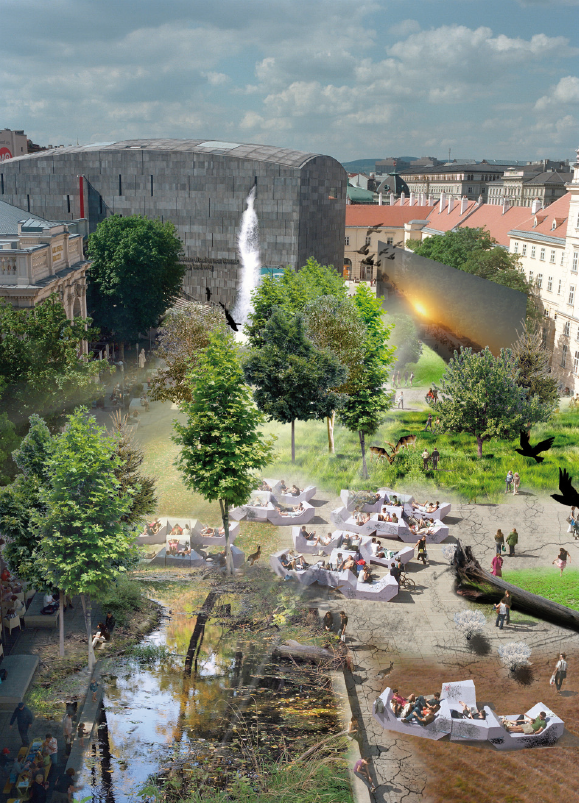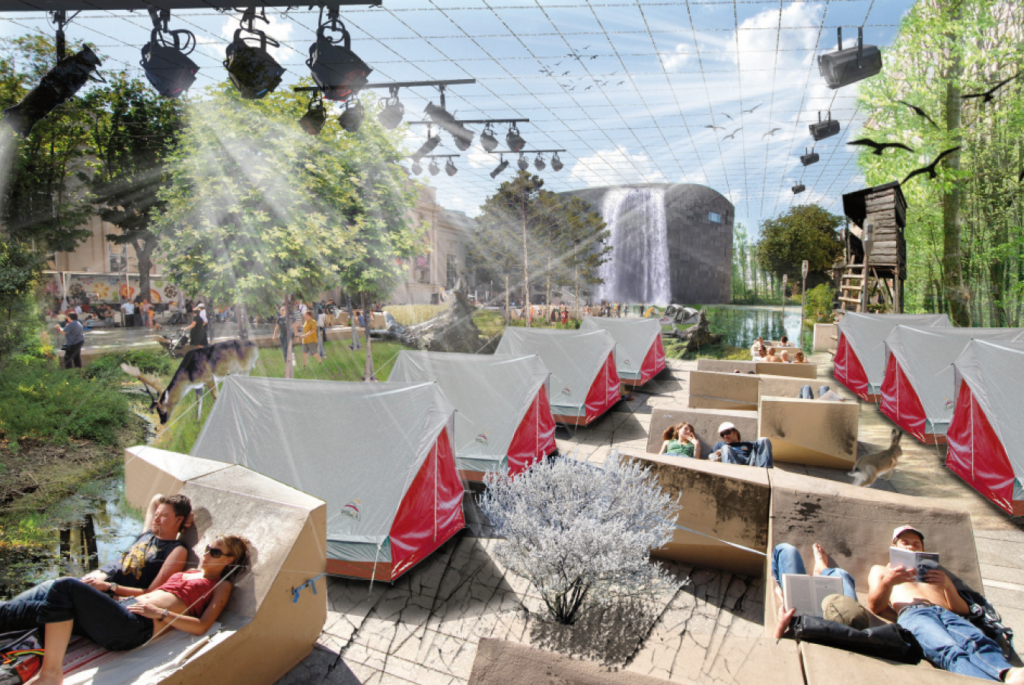
19 Jun World city means forest city
A land strategy for Austria is being adopted these days, which unfortunately does not stop further sealing. Yet there are vacant properties with a floor area the size of the city of Vienna. Land recycling and densification are the right strategies for the times. However, ideas that have been on the table for a long time could also be recycled and compacted.
The MuseumsQuartier has decided to launch a greening offensive, which it has advertised to the public under the title “MQ goes green”. Reducing the heat island with the most creative approaches possible – an important advance for the internationally renowned quarter! Ideas that allow us to breathe a sigh of relief and could have a sustainable impact in terms of sustainability. After all: today, Weltstadt means Waldstadt.
An unofficial national park in the heart of Vienna
In 2011, shortly before I had the opportunity to look into the future of the Tabakfabrik Linz, I was invited by the Federal Ministry to apply for the position of Managing Director of the Museumsquartier. I did so with a concept for an unofficial national park in the middle of Vienna. Local and international artists were to be responsible for its design. A biosphere in the middle of the city in which the themes of identity, society, work, space, economy, ecology, religion, civilization and culture were to be negotiated and played with. I planned 25 tons of native soil for the inner courtyard of the MQ, and hundreds more were to follow – in the form of hills and paths, lushly planted, laid out between ponds and trees.
The museums were connected at lofty heights with aluminum walkways and nets were stretched between them as a lightweight courtyard ceiling. Lights and sprinkler systems were mounted on the aluminum trusses. Wind machines and loudspeakers were also installed. That was the concept. Suspension bridges and footbridges were added as well as high stands, tree houses, a small campsite, campfire sites and a nudist zone.
The growing installation in the public space of the MQ soon eclipsed any stage set in terms of size and opulence in my imagination and quickly established itself as a backdrop for events of all kinds. Instagramability included, although that didn’t exist back then.
A social sculpture at the intersection of politics and art
I saw it as a combination of theatrical installation and social intervention and gave people and nature space to unfold in the middle of the metropolis of Vienna, accompanied by political and artistic art. The spectrum ranged from “transcultural” encounters and conversations to discussions on topics such as “minority rights vs. majority claims”, “tolerance, divergence & discrimination”, “homeland & identity” and even cooking goulash together and dancing the night away.
The installation at the intersection of politics and art described a repositioning and function of the MuseumsQuartier as an area that can be used in a variety of ways, giving visual space to the state of the world and options for its change.
At the same time, the social sculpture heralded a process. It was to lead to joint exhibition and event concepts and also establish the public space of the Museumsquartier as a place of art, reflection and aesthetic-political-social exchange. The concept envisaged transforming the event and leisure area into artistically and scientifically charged laboratories that confront society with its opportunities and challenges. A kaleidoscope of current topics was to find its way into the MQ and constantly seep into the individual institutions, corresponding with their content and thus creating a cosmos of contemporaneity.
Underground rivers and blasted mountain peaks
My venture was rejected at the time. Fortunately – for Vienna and for me. As a result, a production at Theater Hausruck went ahead and I was free for the call from Tabakfabrik that followed shortly afterwards. Before this happened, I received a complaint for “theft of a mountain peak”. The reason for this was the excavated area for the appropriately named play “Neuland” during the Ars Electronica Festival 2011.
Today, peaks are no longer being stolen, they are blowing themselves up – as a result of anthropogenic climate change. This utopia didn’t even occur to me at the time, but it just happened in Tyrol. At the same time, researchers are thinking aloud about bringing rivers that we have banished underground back to the surface. In Vienna, think of Krottenbachstraße or Alserbachstraße, which provide indications of where cooling streams could now flow.
We now have to laboriously nurture and care for delicate little plants like the “MQ goes green” initiative. They should find many imitators all over the world. Public space should be a reflection of ideas, freedom, art and nature.

An art space shows the world and no longer wants to be a forecourt [excerpt from the application]
Free-range hares romped around in it and playfully referred to the gripping Joseph Beuys exhibition at the MUMOK. On the right-hand side were political swamps that heralded the breaches in society. On the left a shelter for the homeless and in the middle a Com.Posting.Haufen. In the arranged political landscape, visitors encountered cornflowers, carnations and German oaks, whose meanings were revealed to them via smartphone and QR code. A high stand served as a Speakers Corner in the middle of the children’s forest. In it, young biologists and geologists searched for surprises in the fauna and flora or for mineral resources.
A forest nature trail led to the Walddorf(!) kindergarten and the walk-in petting zoo. There was also a collectively cultivated herb garden along the way, which provided historical information about witches, healers and hanging gardens. The nudist zone, on the other hand, was out of sight. Well-secured campfire sites established a barbecue culture in the MQ. And every Thursday, the MQ rehearsed the end of the world and staged artificial natural disasters, while on summer weekends the Waldbühne courted theater audiences. Writers presented poetry in the clearing, and Michael Häupl, who holds a doctorate in biology and was until recently the mayor of Vienna, gave a scientific lecture.
The Waldkronenweg guided recreation seekers to the “Waldesruh” pixel hotel or to campsites in the artificial forest. In the clearing of enlightenment, believers, sectarians and skeptics, agrarian rebels and ecologists of all kinds were on hand to answer questions. Fairytale lessons (also) for children: elves, gnomes and forest rascals were on the literary menu. Intermuseal collaborations tackled the theme of the forest, as did theater, media art, architecture and design. Prose seminars for hunter’s Latin and other forest languages rounded off the educational program.



